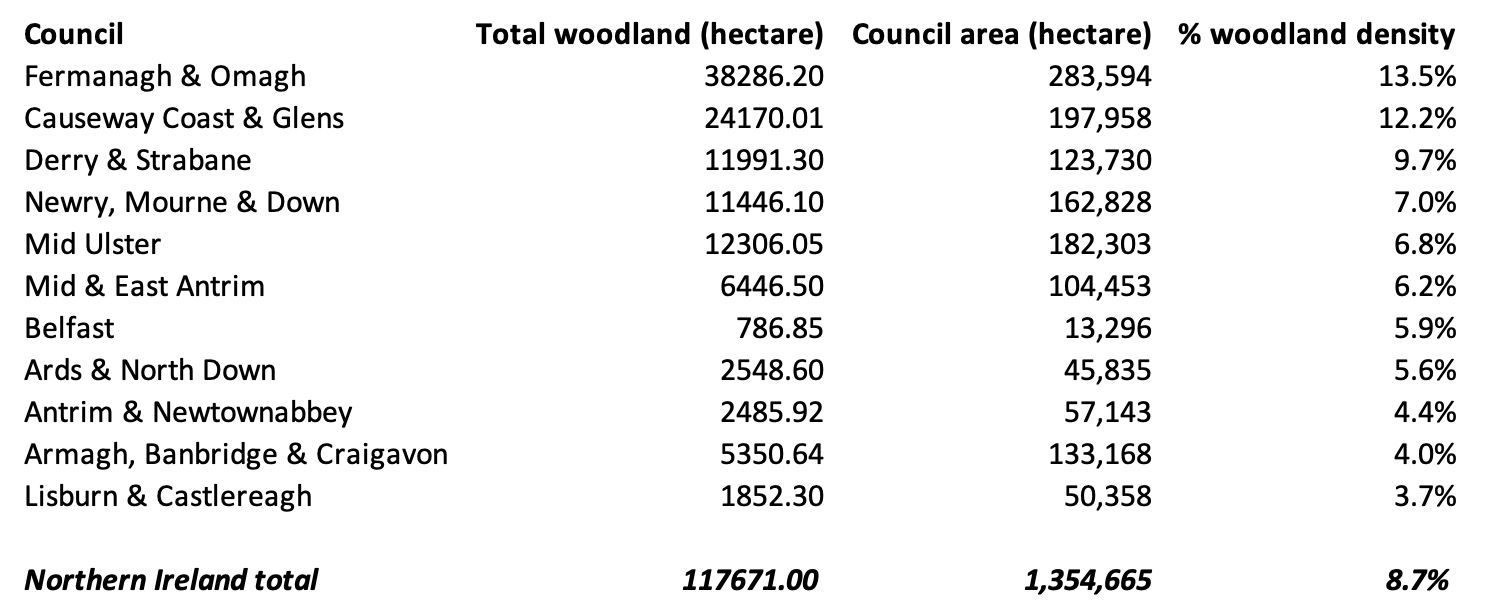- NI’s official Woodland Register records woodland for each local council area, rather than for parliamentary constituencies like Lagan Valley.
- However, Lagan Valley is mostly contained within Lisburn & Castlereagh, the council with the lowest proportion of woodland cover, while the rest of the constituency is in Armagh, Banbridge & Craigavon – the second least wooded council.
- There is no comprehensive, publicly-available data for ancient woodland.
On 18 June, Alliance Party MLA Sorcha Eastwood claimed on Twitter:
“Lagan Valley is one of the least wooded areas in NI, particularly re ancient Woodland.”
This claim is mostly backed by evidence.
The Woodland Register does not provide a breakdown of tree cover for each Assembly/Westminster constituency. However, it does so for each council area.
Most of Lagan Valley is contained within Lisburn & Castlereagh, which has the lowest woodland density of any council. The rest of the constituency is within Armagh, Banbridge & Craigavon, which has the second lowest density.
Therefore, it is fair to say that Lagan Valley is one of the least wooded areas in NI.
There is no comprehensive, publicly-available evidence for the second part of the claim, relating to ancient woodland, so it cannot be substantiated.
- Total woodland
The Department of Agriculture, Environment and Rural Affairs (DAERA) maintains a Woodland Register. The latest figures published are for 2022 and measure the number of hectares of woodland by council area and by county, though not by Assembly/Westminster constituency.
Overall, Fermanagh & Omagh District Council has the greatest area of woodland, and Belfast City Council has the least.
However, council areas can vary significantly in size – Belfast is by far the smallest council, geographically – and this should be factored in.
- Woodland density
The latest information on the area of each council can be found in the Population Density statistics from the 2021 Census. The land area is based on detailed spatial mapping data from Ordnance Survey NI (OSNI) using the international guidelines for Standard Area Measurements (SAM).
The following table shows the area of woodland, overall area, and woodland density of each of the 11 councils, and of Northern Ireland as a whole.

Figure 1 – source: derived from DAERA and Census 2021 figures
Lisburn & Castlereagh is the least densely wooded council (3.7%) in Northern Ireland, followed by Armagh, Banbridge & Craigavon (4.0%) and Antrim & Newtownabbey (4.4%).
Belfast is the fifth least densely wooded council (5.9%), well under the Northern Ireland average.
The most densely wooded council is Fermanagh & Omagh (13.4%), nearly four times more dense than Lisburn & Castlereagh.
Overall, Northern Ireland is 8.7% wooded.
- The claim
The claim refers to Lagan Valley, the Assembly and Westminster constituency. Although the Woodland Register doesn’t include that breakdown, the majority (around three quarters) of Lagan Valley falls within the boundary of Lisburn & Castlereagh City Council – and the other portion falls within Armagh, Banbridge & Craigavon, the next least densely wooded council.
Based on all this, Ms Eastwood’s claim that “Lagan Valley is one of the least wooded areas in NI” is backed by evidence – although the precise figures are available broken down by council areas, rather than Westminster/Assembly constituencies.
- What about ancient woodland?
According to the Woodland Trust charity, ‘ancient woodland’ can be defined as:
“Ancient woods are areas of woodland that have persisted since 1600 in England, Wales and Northern Ireland, and 1750 in Scotland. This is when maps started to be reasonably accurate so we can tell that these areas have had tree cover for hundreds of years. They are relatively undisturbed by human development. As a result, they are unique and complex communities of plants, fungi, insects and other microorganisms.”
Woodland Trust told FactCheckNI that they don’t have any specific reports or figures for the level of ancient woodland in Northern Ireland.
Their Ancient Tree Inventory tool allows members of the public to record the location, species, height, girth and condition of ancient trees. Trained volunteer verifiers assess submissions and accompanying photographs to determine whether they are indeed ancient trees.
However, this database is not comprehensive and cannot help determine whether there is a particular lack of ancient woodland in the Lagan Valley constituency or Lisburn & Castlereagh City Council.




